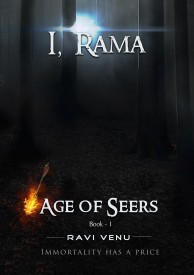[Book Review] I, Rama: Age of Seers (Book – 1) by Ravi Venu
16 Jul 2012 Share on:
Ramayana has been the epic the story of which has been told and retold and is still being told. There is an enchanting literary colour that has been liked by many and is still being liked and loved.
[caption id="attachment_1697" align="alignright" width="141"]
 [/caption]
[/caption]
“I, Rama” – is an unique first person account of how the famed Hero-monarch would narrate his tale, as seen by him, his point of view of the spectacular events that unfold, chronicling the path which immortalized his name, from a mere prince to the very epitome of manliness. The first volume of the series starts with Rama in his late years, narrating his tale to his sons and close friends. The characterization models itself on how an evolved human who has been transformed into a super hero guided by imbibing the distilled essence of the supreme spiritual masters. The story has been told and re-told several times that I will not mention it here. Nevertheless, there are certain things about the book that are worth mentioning over here. (ref)
We all know that character and personality of Rama is synonymous to that of the perfect being, the ideal person. Ramayana depicts the duties of relationships, portraying ideal characters like the ideal father, ideal servant, the ideal brother, the ideal wife and the ideal king. The ideal portrayed by the character of Rama has been unfathomable by a common being, a common man can hardly think of himself to be a Rama but he always wants to be him. Throughout the book, Ravi Venu has projected Rama experiencing human emotions and vulnerability that every human faces whether when he is talking about his father Dashrath, or talking about his stepmother Kaikeyi or Sita or anyone else.
Ravi Venu has also tried to portray some of the main characters of Ramayana in a different light by bringing a new twist in the story. We all know that Kaikeyi was responsible for sending Rama into exile to put her son on the throne. She is portrayed as an intelligent warrior queen who was responsible to make Rama choose to go for exile and thus end Ravana and his misdeeds. I liked this portrayal of Kaikeyi’s character. This is something unique and I liked howRavi has presented this in his story of Rama. Moreover, all the female characters have been presented as having strong character and virtues, which is a good thing to be seen in the literature and a welcome change from the regular portrayal of female characters. Hope this trend grows further.
The significant portion of the book is devoted to Seers and Sages and details the lives of some seers and sages among which story of Vishwamitra and Meneka has been told again. Also, a significant portion of the novel is devoted to Raja Dashrath, father of Rama and the relationship of Rama with him.
I know that some people are definitely not going to like the portrayal of different characters that the author has taken the liberty to sketch differently. However, there is bound to be different understanding of epics by different people and I am all open to accept this liberty. Even the epic Ramayana as it currently stands and attributed to Valimiki has been the work of thousands of years and has added to the original story and is the work of understanding, thought and visualization of numerous authors.
A quote from the book that I liked,
...nobility is defined by the way one conducts his life...
I really liked reading the book and hope and appreciate the wayRavihas tried to redefine the epic. This is the first part of the trilogy and eager to read the next two books lined up in the series.
This review is a part of the Book Reviews Program at BlogAdda.com. Participate now to get free books!
Related articles
- I, Rama or Ayyo, Rama ! (thatandthisinmumbai.wordpress.com)
- The Most Epic Narrative of Ramayana on the Internet (beautifulpixels.com)
- Review: I, Rama Age of Seers Book 1 - Ravi Venu (mychocolethandbag.wordpress.com)
- Watch this: the interactive story of Ramayana in Google Chrome (theverge.com)
- Rama, the Stitaprajna (thehindu.com)